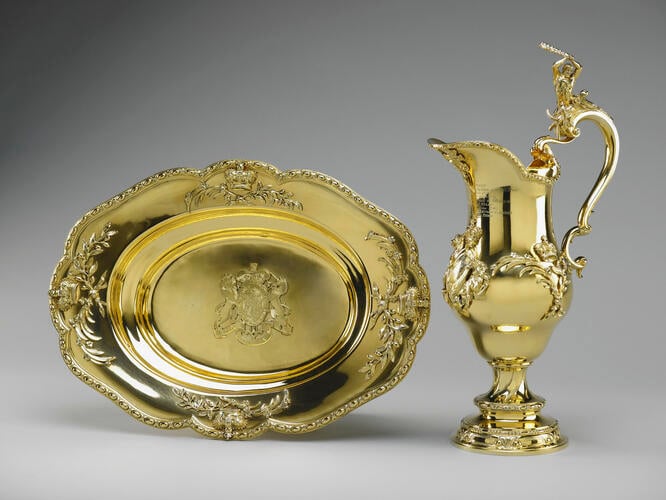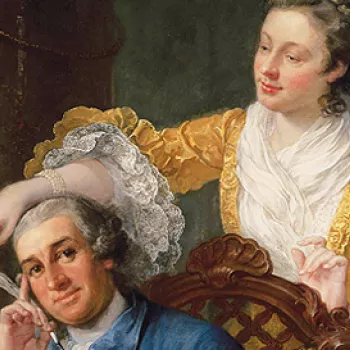-
A silver-gilt pear-shaped ewer on a high stem, the handle cast as a figure of Hercules with upraised club, killing the Hydra. The shaped oval basin is engraved in the centre with the Royal coat of arms, and has a beaded border with applied crowns and laurel branches.
The Gentleman’s Magazine of May 1738 stated that ‘This morning between 6 and 7 the Princess of Wales was happily deliver’d of a Prince at Norfolk House, St James’s Square, the Archbishop of Canterbury being present… The same day the newborn Prince was very ill and at 11 at Night was privately baptiz’d by the Bp of Oxford by the Name of George; but next Day was much better and her Royal Highness in a fair Way’. The engraved inscriptions on the ewer and basin themselves indicate that they were used during the ceremony at Norfolk House.
These works do not appear in the 1738 ledgers of the Prince’s goldsmith, George Wickes. They may be the ewer and basin for which he was charged in 1742, though such a delay for such an important commission seems unlikely; it may be that the work was supplied through another goldsmith. There is a third possibility, which is that the ewer and basin were created with some other purpose in mind. Both parts lack any imagery associated with christenings and the figure of Hercules slaying the Hydra, which forms the handle of the ewer, seems particularly inappropriate. It is has been suggested that it may represent the Church Triumphant, but this would represent an unusually tenuous allegorical device. Prince George was dangerously ill on the day of his birth and was baptised that evening; in the circumstances any vessel to hand might be used expeditiously. This possibility seems to be confirmed by the inscription itself, which suggests that the font was not used again until the baptism in 1780 of George III’s own son, Prince Alfred. For other christenings the royal family reverted to their traditional receptacle - the font and basin created for Charles II (RCIN 31739). Moreover there is evidence that the coats of arms on the pieces, which date from the reign of George III, were engraved over another set of arms. These might have been Frederick’s arms or some other’s, as it is surely possible that the ewer and basin were hastily presented by a third party for the occasion of the christening.
The oval shape of the basin and its deep well are associated with French design of the period, and it is probable that it was created by one of the Huguenot goldsmiths working in London at the time. Lewis Pantin worked closely with Wickes and is known to have supplied other plate to Frederick, such as the salver which he presented to the city of Bath on his visit there in 1738.
Text adapted from The First Georgians; Art and Monarchy 1714 - 1760, London, 2014.Provenance
Acquired by Frederick, Prince of Wales in 1738
-
Creator(s)
Acquirer(s)
-
Medium and techniques
Silver gilt
Category

Search results
Start typing
- Home
- /
- Collection
- /
- Explore the Collection
- /
- Ewer and basin
- /
Featured in
Keep in touch
Sign up to e-mail updates for the latest news, exclusive events and 15% off in our online shop.
We will look after your data in accordance with our Privacy Notice.
Quick Links
The income from your ticket contributes directly to The Royal Collection Trust, a registered charity. The aims of The Royal Collection Trust are the care and conservation of the Royal Collection, and the promotion of access and enjoyment through exhibitions, publications, loans and educational activities.









